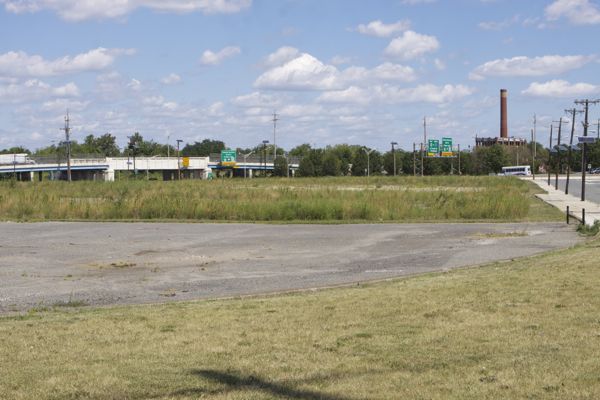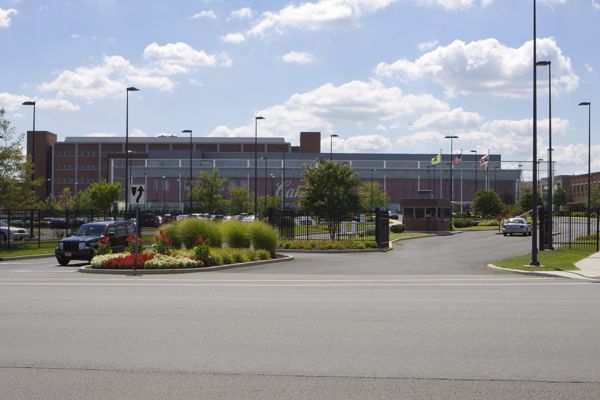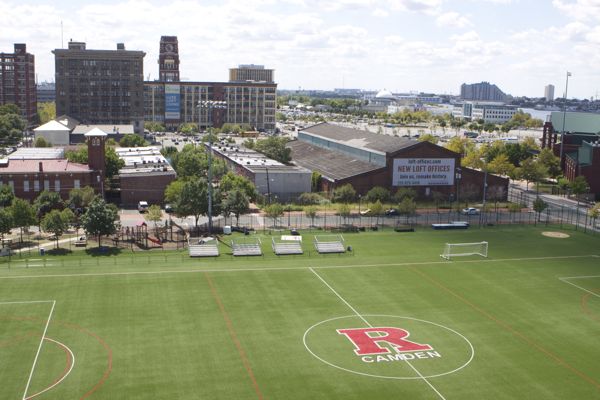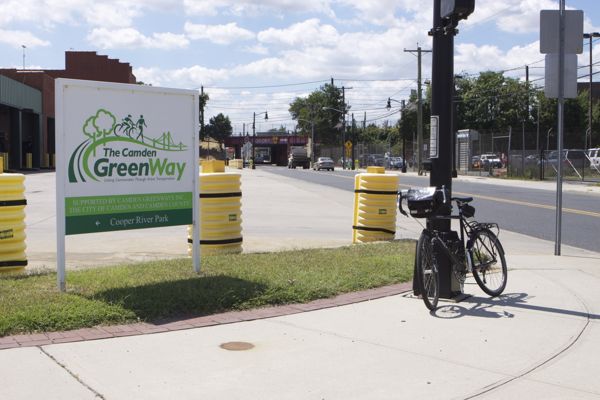Christie Subaru Subsidy Creates Camden Corporate Compound
“Gateway District” Is Segregation By Design
An Archipelago of Harsh Private Spaces
Clueless Conservationists Provide Political Cover: “Beg For Rain Garden”
[Correction and Update below]
The Philadelphia Inquirer story about the Christie Administration’s most recent corporate subsidy to relocate Subaru from nearby Cherry Hill to Camden prompted me to take the challenge laid down by architectural critic Inga Saffron: (Changing Skyline: It’s What Makes Subaru A Tax Dodge):
“Should any employees be adventurous enough to commute by PATCO, the River Line, or NJ Transit bus to the Walter Rand Transportation Center in downtown Camden, they will face almost a mile’s walk along the mini-highway of Martin Luther King Boulevard. Only 65 percent of Camden adults have access to cars, so the lack of transit hits them hard. Bike paths and new transit stations have been promised, but in some vague, far-off future.
So, being an adventurous cyclist and semi-trained dabbler in urbanism, I hopped on the Riverline with my bike and headed down to Camden to see the new Subaru site. Here’s what I found.
Urban Design Fail
The Inquirer critic was harsh, but actually understated the conditions I saw:
To hear state and city officials tell it, Subaru’s decision to take up residence in Camden is the first step in establishing a vibrant new urban district on the edge of downtown. But what it really does is import sprawl into a city hungry for density. And New Jersey taxpayers will be the ones to pick up the tab for this wasteful, antiurban land deal.
When suburban companies make the move into cities, they typically bulk up in height to fit in with their urban compatriots. Not so here. Subaru will leave a relatively tall building (seven stories) in the suburbs for a shorter one (four stories) in the city. Subaru’s new home, sized for 600 employees, will be a lonely island in an asphalt sea containing 1,031 parking spaces. […]
The entire 13-acre Gateway District, which includes the Subaru project, is being developed by Brandywine Realty Trust, the company responsible for the cluster of glass towers at Philadelphia’s 30th Street Station. It’s pitching Gateway as Camden’s answer to the Navy Yard. If so, it’s a poor-man’s version, with no meaningful street grid, no inclusion of interesting older buildings, no aspiration for true urbanity.
The phrase “aspiration for true urbanity” got me thinking that over 50 years ago, in the classic 1961 self described “attack on city planning and rebuilding”, Jane Jacobs emphasized “the intimate and casual life of cities” in setting forth her own groundbreaking observations and principles of what makes cities work – observations obviously lost on the Christie Camden Crew:
One principle emerges so ubiquitously …. is the need of cities for a most intricate and close grained diversity of uses that give each other constant mutual support. … Cities are fantastically dynamic places, and this is strikingly true of their successful parts, which offer a fertile ground for the plans of thousands of people. ~~~ “The Death and Life of Great American Cities”
I don’t think I could find anything further from Jacobs’ principles than what I saw in Camden’s “Gateway District”.
Instead, I found the nightmare James Kunstler wrote about 32 years later in his 1993 book “The Geography of Nowhere”:
Thirty years ago, Lewis Mumford said of post-World War II development, “the end product is an encapsulated life, spent more and more either in a motor car or within the cabin of darkness before a television set.” The whole wicked, sprawling, megalopolitan mess, he gloomily predicted, would completely demoralize mankind and lead to nuclear holocaust.
It hasn’t come to that, but what Mumford deplored was just the beginning of a process that, instead of blowing up the world, has nearly wrecked the human habitat in America… the everyday landscape becomes more nightmarish and unmanageable each year.
Most recently, Chris Hedges nails it in his 2012 book “Days of Destruction, Days of Revolt”. Chapter 2 “Days of Siege” focuses on Camden:
Camden sits on the edge of the Delaware River facing the Philadelphia Sky-line. A multi-lane highway, a savage concrete laceration, slices through the heart of the city. It allows commuters to pass overhead, in and out of Philadelphia, without seeing the human misery below. We keep those trapped in our internal colonies, our national sacrifice zones, invisible.
So, in light of that Jacobs – Kunstler – Mumford – Hedges context, let’s take a look at the Subaru “Gateway District” site – it’s obviously been selected as an easy in and out location for car commuters using I-676: 
But, as Hedges notes, the Subaru development is actually worse than car dependent sprawl being imported into the City.
It will create another gated private corporate compound –
Campbell’s Soup already is a secured, gated, artificially landscaped, and fenced compound for suburban commuters that virtually screams “urban gangsters get lost” – the guard at the gate even told me NOT to take photographs “from their sidewalk”:

I might as well have been in the Green Zone in Baghdad.
But Campbell’s is not an anomaly – as I tried to make my way back to the Walter Rand Transportation Center, I came upon Cooper Hospital, the next compound, see:
And then I came upon Rutgers, another compound – an archipelago of restricted private space intentionally separate from the City of Camden and its people – note the appeal to “New Loft Offices” and on the building in the background to gentrifying “Lux Loft Living”: 
And this gated corporate world is driven by a racist logic.
Corporate Subsidies Bypass the Hood
While millions of dollars flow into corporate subsidies like the Subaru deal – Camden’s collapsing neighborhoods and the people who live there are left behind:
Conservationists in the City
In addition to the warped urban vision, the urban design fail, and the corporate subsides, the Inquirer story raised the important issue of the role of conservationists in the city.
During the open space debate, I criticized that role as opportunistic, manipulative, self serving, and basically racist.
Opportunistic photo-ops with black children in urban parks and political events with urban leaders in the run-up to a self serving Open Space ballot question is way over the top in my book.
But the Inquirer story reveals a whole other level of what could be described either – at best – as naive and ill informed co-optation, or perhaps more accurately as actively complicit in providing political cover for Gov. Christie’ corporate anti-urban agenda, while extracting the benefits of Foundation funded feel good tokenism:
As a company, Subaru has gotten a lot of mileage out its reputation for environmental responsibility. Yet here, it seems oblivious to those concerns. The New Jersey Conservation Foundation has been begging the company to include the same rain gardens Subaru has in Cherry Hill to help control flooding on Admiral Wilson. A request for a bike-trail connection to Gateway Park has also gotten little traction.
Oh boy. Where to start?
When rain gardens and bike-trail connections become the “public interest” “advocacy” benchmarks of revitalization of our cities – efforts funded by NJ’s largest Foundations – then something has gone horribly, horribly, wrong.
Which takes me to my parting shot.
Sustainable Shills
I have been critical of the “sustainability” crowd – the recent post on Woodbridge being the latest example of the fraud that parades under the “Sustainable NJ” banner, a fraud generously funded by NJ Foundations and NJ corporations, as well as the Christie Administration.
For those criticisms, I’ve gotten pushback and harsh criticism from a handful of SNJ fans
[Update: CORRECTION – today, 9/26/15, After a 350.org meeting today, out of the blue, a woman with a nametag “Lori”, who I now learn is Ms Braunstein, angrily told me to take this down, that it was wrong, and that her husband was an accountant in Philadelphia.
Since I had never met Ms. Braunstein, I initially had no idea who she was and what she was talking about and asked for clarification – what specifically did I write that was wrong and what was her name, husband, etc. She just kept saying her husband was an accountant and that I needed to take this down. After I asked for specifics, she got frustrated and walked away.
I’ve since contacted my source for this claim and asked for clarification. Mr. Molotsky is not Braunstein’s husband – my apology for the error. I relied on my source without confirming the facts. ~ end update]
CORRECTION – 9/26/15
[Update: 9/10/15 – Read this Report by NJ Policy Perspective – the corporate subsides in Camden are over $300,000 per job!
Risky Business: New Jersey Must Hold Corporations More Accountable in Subsidy Deals ~~~ end update.]

